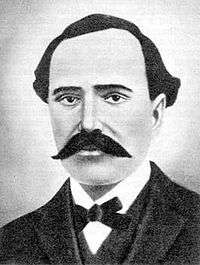Kostandin Kristoforidhi
| Kostandin Kristoforidhi | |
|---|---|
|
Picture of Kristoforidhi by unknown author | |
| Born |
1826 Elbasan, Ottoman Empire (now Albania) |
| Died | 1895 (aged 69) |
| Pen name | Kristoforidhi |
| Occupation | translator, writer |
| Nationality | Ottoman |
| Period | 1846–1895 |
| Notable works | Translation of the New Testament |
Kostandin Nelko, known as Kostandin Kristoforidhi, 1826–1895) was an Albanian translator and scholar. He is mostly known for having translated into Albanian the New Testament for the first time in the Gheg Albanian dialect in 1872. He also provided a translation in Tosk Albanian in 1879 thereby improving the 1823 tosk version of Vangjel Meksi. By providing translation in both dialects, he has the merit of founding the basis of the unification of both dialects into a national language.[1]
Life
He was born in Elbasan and from 1847 studied at the Zosimea Greek college in Ioannina, where he helped Johann Georg von Hahn learn Albanian and write a German-Albanian dictionary.[2]
He went to Istanbul in 1857, and drafted a Memorandum for the Albanian language. He stayed in Malta until 1860 in a Protestant seminary, finishing the translation of The New Testament in the Tosk and Gheg dialects. He was helped by Nikolla Serreqi from Shkodër with the Gheg version of the Testament. Nikolla Serreqi was also the propulsor for the use of the Latin alphabet, which had already been used by the early writers of the Albanian literature and Kristoforidhi embraced the idea of a Latin alphabet.[3]
He went to Tunis, where he worked as a teacher until 1865, when a representative of the British and Foreign Bible Society contracted him to work for the company to produce Bible translations into Albanian. He published in 1866 the first Gheg translation of the four Gospels and the Acts of the Apostles; for the many years to come, he continued his work, publishing in the Tosk and Gheg dialects The Psalms (1868, 1869); The New Testament (1879, 1869), Genesis and Exodus (Tosk, 1880); Deuteronomy (Tosk, 1882); The Proverbs and the Book of Isaiah (Tosk, 1884).
His most important work, The Dictionary of the Albanian Language (Greek: Λεξικόν της Αλβανικής Γλώσσης) – (Albanian: Fjalori i Gjuhës Shqipe), was published in Athens, Greece, in 1904, 25 years after it had been drafted by Kristoforidhi and after his death. It was written in Greek.[4]
Works

- Istoria e shkronjësë shënjtëruarë. (1872)
- Λεξικὸν τῆς ἀλβανικῆς γλώσσης Lexikon tēs albanikēs glōssēs (Greek-Albanian Dictionary)
- Γραμματική τῆς γλώσσης κατὰ τὴν τοσκικὴν διάλεκτον Grammatikē tēs glossēs kata tēn toskikēn dialekton (1882)
- Abetare. (ABC-Primer, Gheg 1867, Tosk 1868)
References
- ↑ Albanian literature in Greek script
- ↑ Robert Elsie (24 December 2012). A Biographical Dictionary of Albanian History. I.B.Tauris. p. 257. ISBN 978-1-78076-431-3. Retrieved 7 January 2013.
- ↑ Lloshi pp.14–15
- ↑ Lloshi p. 9.
Bibliography
- Akademia e Shkencave e Shqipërisë (2008) (in Albanian), Fjalor Enciklopedik Shqiptar 2 (Albanian encyclopedia), Tirana, ISBN 978-99956-10-28-9
- Mann, Stuart: Albanian Literature: An Outline of Prose, Poetry, and Drama, London 1955.
- Gawrych, George W.: The Crescent and the Eagle: Ottoman Rule, Islam and the Albanians, 1874–1913, New York 2006.
- Lloshi, Xhevat (2008). Rreth Alfabetit te Shqipes. Logos.
|first3=missing|last3=in Authors list (help)
Additional readings

- The New Testament of Kristoforidhi (1872 publication in gheg Albanian)
- The New Testament of Kristoforidhi (1872 publication in tosk Albanian)
- Genesis, translation of Kristoforidhi (1889 publication in tosk Albanian)
- Kostandin Kristoforidhi e la biblia Albanese. In: Besa. Nr. 193, Jg. 2007. S. 2–7.
